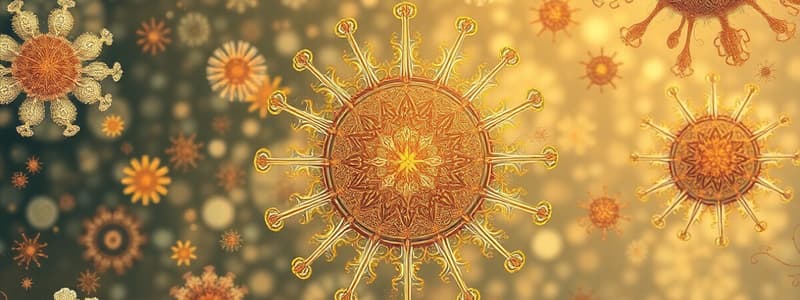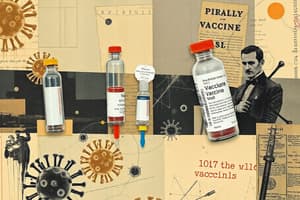Podcast
Questions and Answers
Which of the following best defines immunity?
Which of the following best defines immunity?
- A temporary state of being free from illness.
- The state of protection against infectious disease. (correct)
- The process of getting sick from a disease.
- The body's allergic reaction to foreign agents.
Innate immunity relies on previous exposure to a specific microorganism.
Innate immunity relies on previous exposure to a specific microorganism.
False (B)
Name two ways that passive immunity can be acquired naturally.
Name two ways that passive immunity can be acquired naturally.
Via the placenta or breast milk
Adaptive immunity is characterized by immunological ________.
Adaptive immunity is characterized by immunological ________.
Match the type of immunity with the relevant description:
Match the type of immunity with the relevant description:
Which of the following cells are NOT part of the innate immune response?
Which of the following cells are NOT part of the innate immune response?
Immunization with a vaccine leads to passive immunity.
Immunization with a vaccine leads to passive immunity.
What type of immunity is gained through direct injection of antibodies?
What type of immunity is gained through direct injection of antibodies?
Which of the following is an example of a live attenuated vaccine?
Which of the following is an example of a live attenuated vaccine?
Antitoxins provide long-lasting immunity.
Antitoxins provide long-lasting immunity.
What is the main purpose of vaccines?
What is the main purpose of vaccines?
The BCG vaccine is given against ______.
The BCG vaccine is given against ______.
Match the following immunizing agents with their types:
Match the following immunizing agents with their types:
Which type of immunity is acquired through vaccination?
Which type of immunity is acquired through vaccination?
Gamma globulin provides long-term active immunity.
Gamma globulin provides long-term active immunity.
Immunoglobulins are also known as ______.
Immunoglobulins are also known as ______.
Which type of immunity is NOT present at birth?
Which type of immunity is NOT present at birth?
Artificially acquired active immunity results from the direct transfer of antibodies from another person or animal.
Artificially acquired active immunity results from the direct transfer of antibodies from another person or animal.
What is the primary way naturally acquired passive immunity is passed from mother to baby?
What is the primary way naturally acquired passive immunity is passed from mother to baby?
A vaccine, like the BCG vaccine for Tuberculosis, provides ______ acquired active immunity.
A vaccine, like the BCG vaccine for Tuberculosis, provides ______ acquired active immunity.
Exposure to which of these diseases can lead to naturally acquired active immunity?
Exposure to which of these diseases can lead to naturally acquired active immunity?
Artificially acquired passive immunity results in the production of memory cells.
Artificially acquired passive immunity results in the production of memory cells.
What is the key difference between naturally acquired active immunity and artificially acquired active immunity?
What is the key difference between naturally acquired active immunity and artificially acquired active immunity?
Match the type of immunity with its description:
Match the type of immunity with its description:
Which of the following is an example of a vaccine containing a killed or inactivated microbe?
Which of the following is an example of a vaccine containing a killed or inactivated microbe?
A toxoid vaccine contains a live, weakened form of a pathogen.
A toxoid vaccine contains a live, weakened form of a pathogen.
What type of immunity is provided by an antiserum?
What type of immunity is provided by an antiserum?
The hepatitis B vaccine is an example of a vaccine produced using ______ technology.
The hepatitis B vaccine is an example of a vaccine produced using ______ technology.
Which of these vaccines contain fragments of microorganisms?
Which of these vaccines contain fragments of microorganisms?
Match the following vaccine types with their appropriate examples:
Match the following vaccine types with their appropriate examples:
Immune globulin (IG) provides active artificially acquired immunity.
Immune globulin (IG) provides active artificially acquired immunity.
What is the primary source of antibodies in an antiserum?
What is the primary source of antibodies in an antiserum?
Flashcards
Immunity
Immunity
The ability of an organism to resist infection and disease, either through an immune response triggered by immunization or previous infection, or via other non-immunological factors.
Innate Immunity
Innate Immunity
Refers to the body's innate, non-specific defense mechanisms present from birth. It's the first line of defense against foreign pathogens.
Cells involved in innate immunity
Cells involved in innate immunity
Consists of specialized cells like dendritic cells (DCs), natural killer (NK) cells, macrophages, neutrophils, basophils, eosinophils, and mast cells.
Adaptive Immunity
Adaptive Immunity
Signup and view all the flashcards
Acquired immunity
Acquired immunity
Signup and view all the flashcards
Naturally acquired active immunity
Naturally acquired active immunity
Signup and view all the flashcards
Artificially acquired active immunity
Artificially acquired active immunity
Signup and view all the flashcards
Artificially acquired passive immunity
Artificially acquired passive immunity
Signup and view all the flashcards
Naturally Acquired Passive Immunity
Naturally Acquired Passive Immunity
Signup and view all the flashcards
Natural Immunity
Natural Immunity
Signup and view all the flashcards
Artificial Immunity
Artificial Immunity
Signup and view all the flashcards
Antiserum
Antiserum
Signup and view all the flashcards
Antitoxin
Antitoxin
Signup and view all the flashcards
Gamma globulin
Gamma globulin
Signup and view all the flashcards
Active immunity
Active immunity
Signup and view all the flashcards
Passive immunity
Passive immunity
Signup and view all the flashcards
Immunizing agents
Immunizing agents
Signup and view all the flashcards
Live attenuated vaccines
Live attenuated vaccines
Signup and view all the flashcards
Inactivated vaccines
Inactivated vaccines
Signup and view all the flashcards
Killed or Inactivated Microbial Vaccines
Killed or Inactivated Microbial Vaccines
Signup and view all the flashcards
Fragment Vaccines
Fragment Vaccines
Signup and view all the flashcards
Recombinant DNA Technology for Vaccines
Recombinant DNA Technology for Vaccines
Signup and view all the flashcards
Toxoid Vaccines
Toxoid Vaccines
Signup and view all the flashcards
Immune Globulin (IG)
Immune Globulin (IG)
Signup and view all the flashcards
Passive Artificially Acquired Immunity
Passive Artificially Acquired Immunity
Signup and view all the flashcards
Study Notes
Body Defence and Immunity
- Immunity is the state of protection against infectious diseases. It's gained through immune responses from immunization or past infection, or other non-immunological factors.
Learning Outcomes
- Students should be able to define immunity.
- Students should be able to describe different types of immunity.
- Students should be able to identify methods for acquiring different types of immunity.
- Students should be able to identify different types of vaccines.
Types of Immunity
-
Innate Immunity: This is the non-specific first line of defense against foreign pathogens. It's an integral part of the overall immune response. It's mediated by cells like dendritic cells (DCs), natural killer (NK) cells, macrophages, neutrophils, basophils, eosinophils, and mast cells. Innate immunity is present from birth and is effective against potential infections. It does not rely on prior experience with microorganisms.
-
Adaptive Immunity: This type of immunity develops throughout life. It targets specific pathogens following exposure to specific antigens. It's mediated by B and T lymphocytes, and it features immunological memory. It isn't present from birth.
-
Naturally Acquired: Acquired immunity can be acquired in two ways:
- Passive: Antibodies are received from another person or animal. This protection is usually temporary. Examples include IgG transfer from mother to fetus across the placenta, and IgA transfer from mother to baby in breast milk.
- Active: Antibodies are produced by the immune system in response to the presence of antigens. This protection is generally long-lasting. Naturally acquired active immunity occurs after exposure to a pathogenic microorganism. Examples include infections with diseases like measles, mumps, and chicken pox.
-
Artificially Acquired: Acquired immunity can be artificially achieved:
- Passive: Antibodies are directly injected from another person or animal. This protection is short-lived and provides immediate protection. Examples include using antiserum, antitoxin, and gamma globulin. This is used when the body does not have time to mount a response.
- Active: Antigens are introduced into the body via vaccines to artificially stimulate an immune response. This leads to the production of memory cells. Examples of vaccines include:
- Live attenuated vaccines: measles, mumps, rubella (MMR), BCG (Bacille Calmette-Guerin), oral polio,
- Inactivated or killed vaccines: typhoid, cholera, rabies, polio (Salk),
- Toxoids: diphtheria, tetanus
-
Immunizing Agents
- Vaccines: Immunological preparations used to induce immunity against specific diseases. They are prepared from live attenuated, inactivated, or killed microorganisms, or from antigens produced through recombinant DNA technology; or from toxoids. Examples:
- BCG, which is used against tuberculosis
- Toxoids to combat diphtheria and tetanus
- Polio vaccines, both inactivated and live attenuated forms
- Vaccines against hepatitis, including hepatitis A and B
- MMR vaccine for measles, mumps, and rubella
- Immunoglobulin (Ig): Antibody-containing serum from another person or animal.
-
Examples include:
-
Human immunoglobulin: normal Ig (used for general protection), specific Ig (used to target particular pathogens, e.g., hepatitis B immunoglobulin)
-
Non-human immunoglobulin (antisera): used to fight diphtheria, tetanus, gas gangrene, botulism, and rabies.
-
Studying That Suits You
Use AI to generate personalized quizzes and flashcards to suit your learning preferences.




